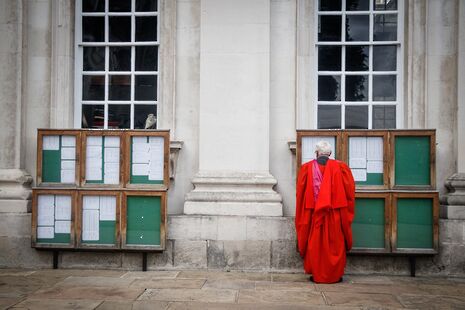CUSU denounces the Tompkins Table – but can it do anything to stop it?
Analysis: By doubling down on its opposition to the table’s existence, the student union risks emphasising a policy which may lack the democratic mandate the sabbatical team claims to have

For years, it is has been a goal for some student campaigners: see the Tompkins table, a yearly ranking of Cambridge’s colleges by their undergraduate exam results, eradicated.
Following its publication this year – and its inclusion of Tripos grades from the over one-third of undergraduates who opted out from their marks being published on the class lists – CUSU reaffirmed its anti-Tompkins stance in a statement posted on its Facebook page yesterday, denouncing its creation by an unnamed tutor, and calling on the University to crack down on the “misuse” of confidential class list data.
It is topic on which CUSU has been silent for some time, given its messy history on the topic of class lists, setting a policy in favour of abolishing the lists that was ultimately overturned by students.
In its statement, CUSU condemned the decision by one college tutor to calculate the table using Peter Tompkins’ formula, in its failure “to respect the wishes of students” and its reflecting “a worrying attitude towards competition and learning”.
When this year’s rankings were published on Saturday, Peter Tompkins, the creator of its formula, told Varsity: “Some people within the University would rather these tables wouldn’t get produced”, adding, “but there are other people who would rather they were”.
Opposing Tompkins opens up a can of worms for CUSU: not only is its mandate to campaign against the table shaky, stopping a ranking from being published requires jumping through a series of technical loopholes. Could it happen?
What do the critics of the Tompkins table say?
Critics, most notably former CUSU President Priscilla Mensah, have raised several criticisms of the Tompkins table as a reductive quantification. They say that in its emphasis on Firsts, the table disregards differences across subjects in the proportion of students who receive a first-class degree. However Tompkins disputes this, as he claims the formula weights scores by subject to a common average, avoiding a skew toward colleges with higher proportions of students in subjects which award more first-class degrees.

Some have also pointed to its inability to consider relative ‘value added’ of grade outcomes – where the value of students’ achievements depends on what educational or financial barriers they faced in working toward their Tripos mark – as rendering the table inherently limited.
Critics point to the table as also ignoring the plethora of college-level factors that may impact students’ experiences of a Cambridge education. These include the impact of varied rent costs, how their college approaches the intermissions process, inconsistent food provision, the flexibility of exam arrangements, the varied impact of access-after-admissions for colleges with different proportions of privately- and state-educated students, lack of choice in accommodation for disabled students, grade trends grounded in an intersection of subject and gender, differing numbers of contact hours, and varied incentives for students to get the top grades.
In their statement yesterday, the CUSU also raised an ideological point, saying the ranking represents “the worst of the academic culture here in Cambridge” in implicitly placing greater value on higher-ranked colleges than lower-ranked colleges.
How is CUSU’s current position on the Tompkins table mandated?
CUSU’s stance on the ranking is unambiguous – with a standing policy to “eradicate” the Tompkins table – but the circumstances under which it which it arrived at the policy are more questionable. CUSU has never undertaken a general vote on its anti-Tompkins stance, unlike its position to support a simple class list opt-out, which it was compelled to adopt following a referendum decision in 2016.

The student union vowed its opposition to the table at a CUSU Council meeting in November 2015: the same meeting where it voted in its ultimately doomed anti-class lists policy, which was overturned in a dramatic referendum a year later. The anti-class lists stance had a limited mandate: 20 votes for, and none against, at a poorly-attended – though by no means exceptionally for the time – session of Council, where attendance by voting members was low enough that it would not be considered quorate by updated standards. The motion opposing the Tompkins table had even less support: 17 attendees voted for, with five against the policy.
Even when the motion to oppose Tompkins ranking was voted on, its proponents offered no supporting data or testimonials. The risk for the student union, therefore, lies in doubling down on a controversial issue for which it has never undertaken a widespread consultation of students. CUSU’s statement yesterday said there is “evidence and student testimony” of the “harmful effects” of the Tompkins table, but these has never been substantiated in any widespread way.
An incorrect version of the policy’s text, lacking Council amendments to remove references to the University’s internal Baxter table, is hosted on CUSU’s website: it says the Tompkins table serves to “foster an unhealthy and destructive culture which is contrary to efforts to target intercollegiate inequality”. The policy will lapse this November, unless renewed.
By attempting to block the publication of the table, CUSU would risk being accused of censorship
Despite CUSU being democratically mandated to reverse its position on class lists, there was no similar assessment on its anti-Tompkins stance, and it is impossible to say what outcome a general vote on the issue would have.
Holding referendums on all aspects of CUSU policy is clearly impractical, but the student union may need to exercise more caution before claiming its stance has the “democratic vote of students”, given the proximity to an episode which damaged its credibility as a representational body.
By attempting to block the publication of the table, CUSU would risk being accused of censorship – this was raised as a criticism when its anti-Tompkins policy was first passed in November 2015, with members also pointing out the potential benefits of the list for aiding constructive comparison.
How could CUSU stop the Tompkins table?
CUSU reaffirmed its opposition to the ranking yesterday, but practically it may find stopping its publication harder to achieve. There are three stages campaigners could aim for: the acquisition of the data, its compilation, and its publication.
Working backwards, stopping publication of the Tompkins table would seem impossible. If compiled, the tables will always find a significant audience and generate considerable interest, making it more or less inevitable it would be published.
Furthermore, stopping anyone from compiling the data would also be difficult: CUSU would have to not only convince Peter Tompkins against creating the table, but also ensure no college tutor with access to the full results compiles the data by simply taking Tompkins’ formula and compiling it.
CUSU’s criticism is focused on the unnamed senior tutor who calculated the data using Tompkins’ formula and confidential full results data, who then releasing the aggregated figures to Peter Tompkins. The crucial point is the data itself.
Cracking down on leaks is rarely simple, and leakers may feel especially empowered to do so suspecting that they have many supporters – it is worth remembering that the University suffered a defeat on the closely-related issue of class lists, having made its own misjudgements about the extent of support for abolition. In a balance between giving college tutors the data and ceding to student demands, the University may favour the former: many staff consider it vital to their colleges’ admissions processes.
Even stopping leaks may not be enough, however. Should the University choose not to release the data internally, it may still be obtainable under freedom of information request, especially as the Tompkins table contains no data that identifies individuals.
In short, the available evidence suggests that as long as there is anyone who wants the Tompkins table – or something like it – to exist, it will.
Updated Friday 3rd August, 3.32pm: The article was updated to include additional context on the Tompkins Table formula.
 Comment / Plastic pubs: the problem with Cambridge alehouses 5 January 2026
Comment / Plastic pubs: the problem with Cambridge alehouses 5 January 2026 News / Cambridge academics stand out in King’s 2026 Honours List2 January 2026
News / Cambridge academics stand out in King’s 2026 Honours List2 January 2026 News / Cambridge businesses concerned infrastructure delays will hurt growth5 January 2026
News / Cambridge businesses concerned infrastructure delays will hurt growth5 January 2026 News / AstraZeneca sues for £32 million over faulty construction at Cambridge Campus31 December 2025
News / AstraZeneca sues for £32 million over faulty construction at Cambridge Campus31 December 2025 Interviews / You don’t need to peak at Cambridge, says Robin Harding31 December 2025
Interviews / You don’t need to peak at Cambridge, says Robin Harding31 December 2025











